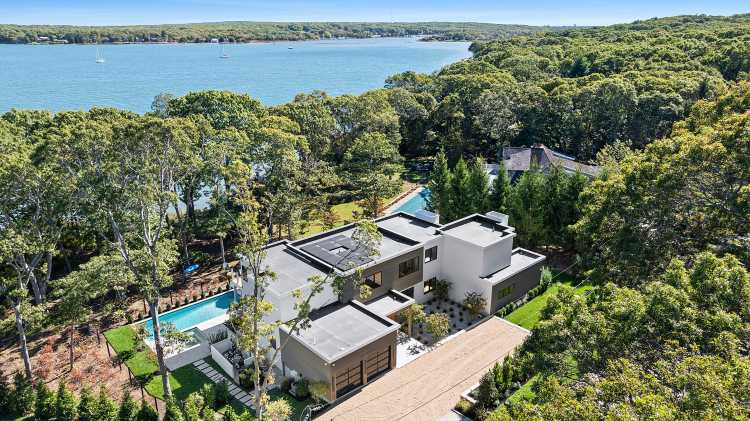
education meeting. Next to him is school board
President Dr. Michael Cohen. (Photo by Frank Rizzo)
The “draft” aspect of a Draft Environmental Impact Statement (DEIS) makes the document a work in progress.
As part of the state-mandated environmental review process, its purpose is to detail how a project could affect a range of issues within its surroundings. These include possible adverse impacts (along with their mitigation), traffic, carbon footprint and air quality, noise, population, property taxes and many others.
Syosset Park, a mixed use development proposed on a 92.8-acre site at the corner of Miller Place and Robbins Lane in Syosset, has engendered much discussion and controversy. It is, pointed out Charles Davis, vice president of development for the site’s co-owners, Simon Property Group, the largest undeveloped property in Nassau County, eclipsing the 72-acre Coliseum Hub in Uniondale.
The official comment period on its DEIS ended on Aug. 31. The site encompasses one state and one federal former Superfund site. Of its acreage, 39 once comprised the industrial Cerro Wire manufacturing facility, which created decades of toxic dumping that needed extensive remediation.
An additional 53.8 acres are made up of the Town of Oyster Bay’s public works department and other operations. The town still holds title, but plans to complete the sale to the developer within the next three years. Thirty-nine acres are taken up by an old town landfill that was closed in 1975 after decades of unregulated dumping. Though it is covered by a cap and topped by a layer of soil and asphalt and concrete, the toxic legacy has made neighbors fearful of what lies beneath and the consequences of the proposed massive construction.

Perhaps there is no more interested party than the Syosset School District. One of its elementary schools, South Grove, is adjacent to the landfill. Another, Robbins Lane, is less than a half mile from the edge of the property. In May, a scoping session on the DEIS was held at Syosset High School attended by more than 700 people.
There, Syosset Board of Education President Michael Cohen and Vice President Tracy Frankel presented a list of concerns, and because of those concerns, the board of education, at its subsequent May 7 meeting, unanimously directed the district to prepare comments in opposition to Syosset Park.
The district officially reaffirmed its opposition at the Aug. 28 meeting, called to present its response to the DEIS.
After mentioning the environmental history of the site, Superintendent Thomas Rogers stated, “We know that they went through some clean-up process. We also know that any construction on those sites has the potential to disturb whatever may remain in the soil.”
Rogers added, “In the law, we are an impacted and interested entity, so we certainly have standing to make comments.”
He went on to note that “We have explored all those things that are within the realm of our expertise—enrollment, facilities, the revenues generated [by the full build-out of the site]. There are obviously things outside of our expertise as it relates to a project of this size and nature.”
To make a study of and critique the DEIS, which runs to about 2,000 pages with appendices, the district hired Walden Environmental Engineering of Oyster Bay.
The firm’s Joseph Heaney told attendees at the Aug. 28 meeting that “the end result of the clean-up was a property that potentially could be reused for industrial purposes.”
Under the proposed mixed use, he noted, the developer needs a “cleaner” standard. That is why it entered into an agreement with the state’s Department of Environmental Conservation (DEC) to subject the Cerro Wire acreage to a Brownfield Program protocol that could clean it up to residential development standards. The investigation will focus on soil vapor sampling, which had not been done in the past. Groundwater sampling at Cerro remains to be done, as existing monitoring wells were found to be dry and new ones will be drilled.
Walden’s Nora Brew said that Cerro Wire was delisted from the Superfund rolls in 1994 because the DEC “had enough evidence that the site was cleaned up to the standards that were in effect at the time, and given the industrial zoning at the site.” Residual levels of “contaminants of concern”—copper, cyanide and zinc—were found not to pose a significant public health risk. A letter from Walden Engineering to Superintendent Rogers detailed further soil and groundwater testing ordered by Syosset Park LLC in 2015-16. They determined that copper, cyanide and certain semi-volatile organic compounds were at levels that exceeded the more restrictive residential standards. Studies also confirmed that “groundwater had not been impacted by historic use of the Cerro site.”
The letter pointedly noted, “Without a final report summarizing the results of the remedial investigation work being completed under the [Brownfield Program], the DEIS is incomplete and does not support a complete evaluation of environmental impacts associated with the former Cerro site.”
The site is still zoned light industrial and Syosset Park LLC is seeking a zoning change to allow mixed use.
Visit syossetschools.org and click on the link to the Syosset Park project for full documentation.
































